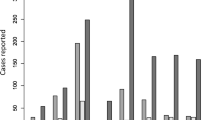Abstract
To estimate the incidence of bacterial meningitis in the Lazio Region, including the city of Rome, and to assess the quality of the surveillance systems, we adopted a multiple-capture model by merging cases from three sources available in 1995–1996: the Notifiable Disease Surveillance (NDS) system, the Special Hospital Surveillance (SHS) system and the Hospital Discharge (HD) registry. A medical record revision was carried out to confirm the cases of bacterial meningitis. A total of 199 individuals was classified as probable or confirmed cases of bacterial meningitis in 1995–1996. In this period, the incidence of reported meningitis was 3.8/100,000 (population = 5,209,633). The log–linear model yielded a total estimated number of 236 cases (95% confidence interval (CI): 206–306), the estimate of incidence reaching the value of 4.5/100,000. Hospital Discharge registry showed the highest sensitivity (77%), the SHS system the highest positive predictive value (83%). In 1997–1998, the meningitis surveillance was integrated with an additional laboratory-based source and yielded 326 cases, with an incidence of reported cases of 6.3/100,000. Laboratory surveillance, involving 115 (92%) public hospitals and 84 (57%) private clinics, contributed 35 (27%) cases in addition to those notified to NDS (n = 130). Multiple-capture models, in our experience could estimate the bacterial meningitis incidence with a very good approximation. In order to improve both sensitivity and positive predictive value of surveillance, hospital and public health sources should be integrated with laboratory-based system.
Similar content being viewed by others
References
Tunkel AR, Scheld WM. Acute meningitis. In: Mandell GL, Bennett JE, Dolin R (eds), Mandell, Douglas, and Bennett's Principles and Practices of Infectious Diseases, 5th edn. Vol 1. Philadelphia: Churchill Livingstone, 2000: 959–997.
Seber GAF. The Estimation of Animal Abundance and Related Parameters. New York: Hafner Press, 1982.
Craigh S. Capture-recapture methods in epidemiological studies. Infect Control Hosp Epidemiol 1996; 17: 262–266.
Hook EB, Regal RR. Capture-recapture methods in epidemiology: methods and limitations. Epidemiol Rev 1995; 17(2): 243–264.
Ackman DM, Birkhead G, Flynn M. Assessment of surveillance for meningococcal disease in New York State, 1991. Am J Epidemiol 1996; 144: 78–82.
McGilchrist CA, McDonnell LF, Jorm LR, Patel MS. Loglinear models using capture-recapture methods to estimate the size of a measles epidemic. J Clin Epidemiol 1996; 49: 293–296.
Abeni DD, Brancato G and Perucci CA. Capture-recapture to estimate the size of the population with human immunodeficency virus type 1 infection. Epidemiology 1994; 5: 410–414.
Ministero della Sanità, Decreto 15 dicembre 1990. Sistema Informativo delle Malattie Infettive e Diffusive. Roma: Gazzetta Ufficiale della Repubblica Italiana, 1990.
Center for Disease Control. Case definitions for infectious conditions under public health surveillance. MMWR Morb Mortal Wkly Rep 1997; 46 (No. RR-10): 15, 24, 44.
Regal RR, Hook EB. Goodness-of-fit based confidence intervals for estimates of the size of a closed population. Stat Med 1984; 3: 287–291.
Hook EB, Regal RR. Validity of methods for model selection, weighing for model uncertainty, and small sample adjustment in capture-recapture estimation. Am J Epidemiol 1997; 145: 1138–1144.
Public Health Laboratory Service. Bacterial meningitis in Europe: Surveillance report for 1995. CDR Weekly 1997; 7: 119–122.
Wenger JD, Hightower AW, Facklam RR, Gaventa S, Broome CV and the Bacterial Meningitis Study Group. Bacterial meningitis in the United States 1986: Report of a multistate surveillance study. J Infect Dis 1990; 162: 1316–1323.
Madsen KM, Schønheyder HC, Kristensen B, Nielsen GL, Sørensen HT. Can hospital discharge diagnosis be used for surveillance of bacteremia? A data quality study of a Danish hospital discharge registry. Infect Control Hosp Epidemiol 1998; 19: 175–180.
Public Health Laboratory Service. Bacteriaemia and bacterial meningitis in Englend and Wales: 1982 to 1996. CDR Weekly 1997; 7: 275, 278.
Connolly M, Noah N. Surveillance of Bacterial Meningitis in Europe 1996. King's College London, October 1997.
Salmaso S, Mastrantonio P, Scuderi G, et al. Pattern of bacterial meningitis in Italy, 1994. Eur J Epidemiol 1997; 13: 317–321.
Noah N, Connolly M. Surveillance of Bacterial Meningitis in Europe 1995. King's College London, December 1996.
Sørensen HT, Sabroe S, Hansen I, Schønheyder HC, Ejlersen E, Hamburger H. Re: "Assessment of surveillance for meningococcal disease in New York State, 1991". Am J Epidemiol 1998; 147: 606–607.
Rivest P, Sagot B, Bedard L. Evaluation of the completeness of reporting of invasive meningococcal disease. Can J Public Health 1999; 90: 250–252.
Author information
Authors and Affiliations
Rights and permissions
About this article
Cite this article
Faustini, A., Fano, V., Sangalli, M. et al. Estimating incidence of bacterial meningitis with capture–recapture method, Lazio Region, Italy. Eur J Epidemiol 16, 843–848 (2000). https://doi.org/10.1023/A:1007650317852
Issue Date:
DOI: https://doi.org/10.1023/A:1007650317852




